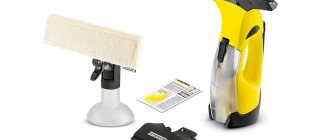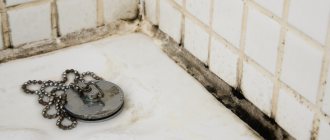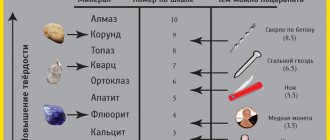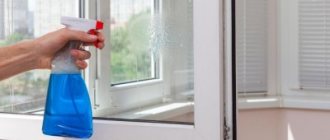Over time, a brand new shiny tile becomes cloudy and covered with various types of dirt or grease. This may happen because you have ignored caring for it for quite a long time, or maybe because it is located in “bad places” - near the stove, where droplets of fat and fumes from cooking get on it, or near the bathroom, where Droplets of soapy, dirty water settle on the surface. In this article we will tell you what is the best way to wash tiles.
Which mop is best for cleaning tiled floors?
A clearing tool with a sponge attachment is ideal for cleaning tiled floors. This mop is the best for cleaning tiled floors, as it does not leave stains or streaks and perfectly removes pet hair. A rope mop has proven itself to be quite good when caring for tiled floors.
Interesting materials:
How to remove yellow sweat stains from colored clothes? How to remove yellow stains from a collar? How to remove greasy wax stains from clothes? How to remove a grease stain from a T-shirt? How to remove grease stains from water-based paint? How to remove chewing gum from a skirt? How to weather a new sofa? How to open BIOS on ASUS? How to call the Boot Menu when booting? How to open the boot menu on Lenovo?
First, a little theory: about the pH of floor tile cleaners
In stores you can find two types of cleaning concentrates and solutions: highly specialized for caring for tiles and/or porcelain tiles and common household ones - for washing any floors and cleaning surfaces in the bathroom/kitchen.
Specialized tile cleaners most often fall into the professional category and are significantly more expensive than mass-market cleaners.
We will not argue that you should overpay and buy a special one. chemicals, since ordinary household products are not suitable for caring for tile floors. Because it's not like that. Whether a tile cleaner is suitable or not depends not only on the brand, but also on the pH value of the aqueous solution.
If the pH of the product is from 5 to 10, the cleaner will not damage the surface of tiles or porcelain tiles. You can add it to your floor cleaning water and even apply it to the floor for 5-10 minutes to remove stubborn stains.
Read the blog: “How to choose an effective and safe detergent.”
Image source - 3dplitka.ru
By the way: professional and household cleaning products are neutral (pH 6-8), acidic (pH 0-5) or alkaline (pH 9-14). Among the last two types there are weak, medium and strong acid/strong alkaline cleaners. Neutral cleaning solutions are suitable for washing tile floors, and weakly acidic and slightly alkaline concentrates are suitable for removing stubborn stains.
A guide to choosing a floor tile cleaner based on pH level
| Weak acid products (pH 4-5) based on citric or phosphoric acid | cope with limescale, cement dust, stains from building materials, efflorescence, organic pollution |
| Weakly alkaline products (pH 9-10) based on sodium hydroxide and potassium hydroxide | suitable for removing grease deposits, soot, soot, oil stains, varnish and paint stains, protein stains (except blood), suitable for cleaning tile joints |
| Neutral products (pH 6-8) | removes street dirt, organic pollution, light grease deposits, light soap deposits |
Note: if the pH value is not indicated on the packaging of the product, rely on the percentage of acid or alkali. Weak acid and weak alkaline include cleaners that contain no more than 5% of the active substance.
Cleaning tile joints
Several recommendations for washing interstitial seams:
- The simplest method of washing seams is to treat them with a soda solution. To do this, you need to dilute baking soda with water until it becomes pasty. Easy to apply with an old toothbrush. Leave for 30 minutes. As a preventative measure, carry out this manipulation every time you clean your apartment.
- If the fungus has already begun to appear, you need to add vinegar to the soda mixture. This product will help fight mold and restore the tiles to their former attractiveness;
- If you want to return the seams to their former whiteness, you can use bleach. The product is applied and left for several minutes.
- Peroxide has proven itself to be excellent in the fight against fungal growths. You need to apply it on a cotton pad and go over all the seams. You can also mix peroxide with detergent. Apply to seams and leave for 60 minutes. After this, rinse the floor with clean water.
- Copper sulfate is an excellent method of fighting fungus. The product is diluted with water and poured into a spray bottle. The tile must be treated with a soap solution, and then apply liquid with copper sulfate.
- Borax is a suitable preparation for combating mold. There is no need to rinse off because it acts as a protective barrier for the flooring.
- Essential oils work well against fungus. Such as grapefruit and tea. The liquid is applied in a diluted state - 1 to 10 and washed off with water.
Homemade detergent
This tile cleaner can be made once for repeated use - just prepare a container where it will be stored. The following “ingredients” will be needed:
- a quarter glass of hydrogen peroxide;
- half a tablespoon of soda;
- one teaspoon of liquid dishwashing detergent.
All you need to do is mix the ingredients thoroughly – and the product is ready for use:
- If the contamination is not severe, then it is enough to apply it to a rag or sponge and rub the tile. Then don’t forget to rinse with water.
- For old, large-scale and severe pollution, a slightly different method. Spray the product onto both the tiles and the grout using a spray bottle and leave for 10 minutes. After that, you should also rub the surface with a cloth or sponge, and then rinse the solution with water and dry the tile.
Why does she stay dirty?
Many owners and housewives are faced with the following annoying problem - the tiles have just been thoroughly washed, but after drying they again take on an unpresentable appearance! There is only one reason for this - unfortunately, you don’t know how to wash tiles. The dirt left behind is due to the following:
- Dirty sponge, rag, napkin. You haven’t washed your “tool” well enough; grease has accumulated on it or pieces of dirt are stuck.
- Not completely rinsed off. In this case, cloudy stains will remain on the tiles. You should change the water several times to thoroughly clean the tiles from the cleaning powder or gel.
- Hard water. Even if you have washed the tiles clean, you should not expect a satisfactory effect with tap water, which contains a lot of salts.
- Uncleaned dirt. This is especially true for greasy stains - not all products can wash them off, but they can be smeared with ease!
- Dirty water. Maybe you were too lazy to change the water when cleaning after it became cloudy? Then yes, in this case the tiles will not look perfect when finished.
Take care to protect your hands
Advice! To make the tiles look like new after cleaning, it is not enough just to use a “super-duper” product and know how to clean the tiles. The correct algorithm of actions is also important.
A lot of sponges and brushes will come in handy
Methods for cleaning old contaminants
There are two methods for removing old stains - mechanical and chemical.
- 1) Mechanical - fighting stubborn dirt with a knife or a metal brush. You should not carry out the processing too intensively, because there is a high probability of damaging it. This cleaning method is well suited for removing old putty and cement after repairs.
- 2) Chemical – treatment of contaminants using chemical solutions.
No. 3. glass cleaner
https://www.youtube.com/watch?v=lfpI2o-BKtM
If a special means for washing tiles is not always at hand, then every housewife probably has a composition for washing glass and mirrors in her arsenal.
Almost every such product contains ammonia, which will help remove minor dirt from the tiles and restore it to its former shine.
The cleaning method is no different from washing windows: you need to spray the composition, and then carefully treat the surface with a soft cloth.
How to wash tiles to make them shine?
This type of flooring can be given shine using special household chemicals containing mastic, as well as using a solution of citric acid, ammonia or vinegar. But it should be remembered that you should not abuse the use of such funds. They negatively affect the condition of the tile joints.
An alcohol solution is safer in this regard. For 4 liters of warm water, take 125 ml of alcohol and, moistening a rag in the resulting mixture, thoroughly rub the clean floor.
No. 2. dishwashing detergent or soap
Light stains can be washed off with regular dishwashing detergent. It is enough to dissolve a small amount of it in warm water until foam forms. The resulting solution is applied with a sponge to the contaminated tiles, left for 10-20 minutes, and then thoroughly washed off with plain water.
Instead of detergent, you can use regular soap (laundry soap is not recommended). To make the dissolution process faster, you can rub the bar soap into warm water. Next, the washing process is similar to that when using dishwashing detergent.
What not to wash
Tile is a durable and practical material. But if care is improper, the service life will be reduced several times. Do not wash tiles:
- using soap. This is the very first thing to remember. Many sources contain opposing advice. But soap leaves the most difficult stains to remove. After washing, you will have to remove them at least 5-8 times with clean water;
- powders with abrasive particles. They damage the surface. The first time, even several hundred times, this will not be noticeable, but after a year and a half, the cracks will become visible to the naked eye. And it will be more difficult to remove dirt each time;
- with hard scrapers or graters. The reason is the same as described above;
- whiteness. This product is often used to clean tiles, but only white ones. On others, it can cause streaks and clouding.
How can I restore after repair?
Before carrying out repair work, the floor surface must be protected as much as possible from all possible contamination. But you will still have to do a more thorough cleaning than usual afterwards.
You can remove silicone sealant or adhesive from tiles using ammonia solutions. They are sold ready-made in construction stores. You just need to dampen a piece of rag and wipe the stain. Some household chemicals designed to remove complex stains are also suitable, especially if they contain a solvent.
Traces of primer or cement are removed with a new solution. It's surprising, but it really works. The old stain dissolves and it becomes very easy to wipe it off with a regular rag.
The grout can be washed with plain water. The main thing is not to delay cleaning. Until the top layer begins to lighten, the grout will be as easy to remove as whitewash.











